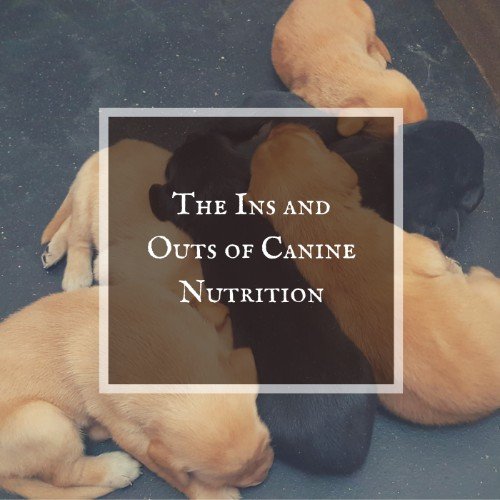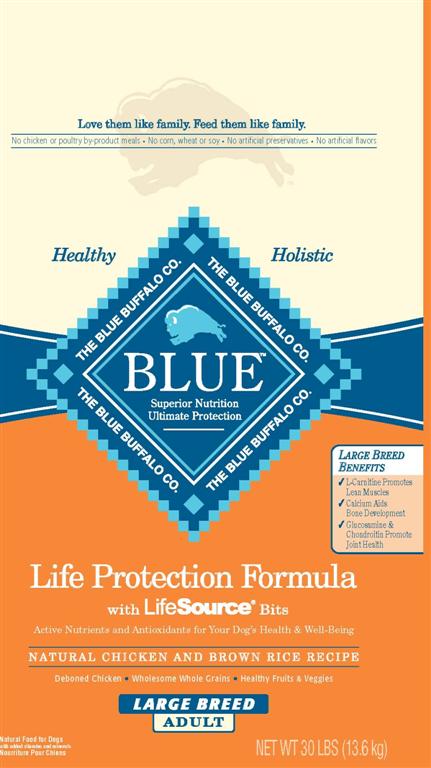
The Ins and Outs of Canine Nutrition
Possibly the most debated subject in the pet industry is what is best to feed your Pointing Lab. As an owner, it can be confusing to say the least. It seems that every time you go to the store there is a new line of dog food available. Deciphering the differences between brands is nearly impossible, you could spend hours in the dog food isle. Did you know though, that companies must follow legal guidelines regarding what is printed on their packaging? These guidelines are set by the federal government and the state in which they manufacture and sell their products. Rules like these are in place to protect us, the consumers, who trust these companies with the care of our animals. At Hunters Point Kennel we pay close attention to the food that we provide our Pointing Labs because nutrition is so vital to their success as a performance and breeding dog. Let’s take a few minutes to help you understand what is required of the companies and how you can become a more educated owner.
Product naming: There are very specific rules about naming dog food. If a product claims that it is 100% chicken, the product MUST be greater than or equal to 95% chicken, but by no means has to be 100%. If you see a dog food variety that is labeled for example as Chicken Dinner, Recipe, Entree, Platter , or Formula , the actual amount of chicken can range from 25%-94%. When the label on the bag reads something like Dog Food with Chicken, the with indicates that less than 25% of the ingredients comes from chicken and could be as low as 4% chicken. Now if the label reads Chicken Flavored Dog food, that means there is, at most, 3% chicken in the total ingredients.
Statement of Intent: A statement of intent is required to be somewhere on the food as well. This means that the company must indicate if the food is for dogs, cats, hamsters, etc. It also must indicate if it is intended to be a complete food or only used as a supplement. The life stage that the product is indicated for should also be listed somewhere on the packaging. Products intended for maintenance are only suitable for fully grown dogs at a healthy weight. If the package states that it is for puppy or growth , the product is suitable for young, growing animals. Products that bear the statement suitable for all life stages meets the nutritional standards required for growth, reproduction, lactation, and maintenance. If you choose a product that meets all life stage requirements, be sure to read the directions because there will likely be different recommendations for each dog.

Nutrition Adequacy: One of the most valuable sentences on the package is going to be the statement of nutritional adequacy. There are a few different ways that a company can go about this. In general pet foods must meet the nutritional requirements set by the Associate of American Feed Company Officials (AAFCO) for each specific breed. The food company can either A) have their feed ingredients formulated to meet AAFCO guidelines and the packaging would have a statement to reflect this. Or the company can B) put their feed through AAFCO feeding trials. If the feed has undergone trials it will be indicated on the packaging that the feed provides adequate nutrition for certain life stages based on AAFCO feeding trials. The feeding trials involve a 6 month test period overseen by a vet during which the animals have their weight, hair-coat, and blood-work monitored regularly.
Guaranteed Analysis: There are 4 values that must be included in the guaranteed analysis: minimum % crude protein, minimum % crude fat, maximum % of crude fiber, and % moisture. Just as an example for a dog on a maintenance diet, the minimum allowed % protein is 18% and minimum 5% for crude fat. Pay attention to the % crude fiber as well. Dogs definitely need fiber in their diet, but a high percentage could indicate that the food uses a lot of filler and you could be getting less for your money.
Ingredients List: The format for the ingredients list follows closely the requirements for the lists printed on foods intended for human consumption. The ingredient listed first is present in the largest quantity in the feed and the ingredient listed last is present in the smallest quantity in the feed. The amount of ingredients in the product however is determined before the feed is made, so if the first ingredient is chicken, it is largest by weight before manufacturing. However, once it is dried in the final product, it may very likely not be the largest ingredient by weight in the end. Another way that food companies can trick you is to split ingredients into their parts so they can be placed lower in the ingredients list. For example, if rice is actually one of their first few ingredients they may split it into ground rice and brown rice in the list to make it seem like a less important ingredient.

Buzz Words :
Grain Free – many pet owners are under the impression that grain is very bad in a dog’s diet. Unless your dog has a certain dietary restriction or allergy there is no need to seek out a completely grain free diet. One of the most common grains in dog food is corn and not even 10% of food allergies in dogs are caused by corn. Consumers looking at grain free diets for their dogs should be aware that grain-free foods are using other sources such as sweet potatoes, carrots, and apples as carbohydrate sources. Those products may end up having a higher carbohydrate content than products that use grains. Those products may also have a higher fiber content than the diets with grain in them. Be sure to look at the guaranteed analysis for nutritional content.
By-products – many companies tout that their products are free of by-products. Having by-products is not necessarily a bad thing if you understand what a by-product actually is. A by-product is something produced during a process that was not the intended product. An example of this could be chicken liver. Humans do not eat as much chicken liver as they do chicken meat so liver could be considered a by-product, and a very good one for dog food companies to include in their food. Certain by-products can also be bad, but there is no need to shy away from every food that lists by-products as an ingredient, however, most quality feeds will not have by-products listed as their first ingredient.
Organic – this is a legally defined statement by AAFCO. A product claiming to be organic must meet USDA organic guidelines. The product can include the organic seal on their label if they are made with 95-100% organic ingredients. If they contain 70-94% organic ingredients they say “made with organic ingredients” and list up to three organic ingredients they used. If less than 70% of the food is organic they can list one organic ingredient in a similar fashion. These products tend to be more expensive because of the additional costs of production.
Natural – this is also a legally defined term by AAFCO. The feed must only contain natural ingredients without chemical alterations or human made products. There are not many 100% natural dog foods on the market currently.
Let’s check out a few popular dog foods for examples of the information above.
Example 1
Let’s look first at Eukanuba Large Breed Puppy Food. Below is information from their website at http://www.eukanuba.com/dog-food/puppy-food/large-breed-puppy-food . This is a typical label that you would see on a package of dog food. You will notice that in bold is the AAFCO statement for nutritional adequacy. This particular food underwent feeding trials and is suitable for growth stages.
| NUTRIENT | ANALYSIS |
|---|---|
| Crude Protein, minimum | 26.0% |
| Crude Fat, minimum | 14.0% |
| Crude Fiber, maximum | 5.0 % |
| Moisture, maximum | 10.0 % |
| Calcium, minimum | 0.65% |
| Phosphorus, minimum | 0.55% |
| Vitamin E, minimum | 140 IU/kg |
| Docosahexaenoic Acid, minimum | 0.1%* |
| Omega-6 Fatty Acids, minimum | 1.93%* |
| Omega-3 Fatty Acids, minimum | 0.39%* |
| Glucosamine, minimum | 375 mg/kg* |
| Chondroitin Sulfate, minimum | 35 mg/kg* |
* Not recognized as an essential nutrient by the AAFCO Dog Food Nutrient Profiles
Animal feeding tests using Association of American Feed Control Officials procedures substantiate that Eukanuba Large Breed Puppy Food provides complete and balanced nutrition for Growth.
Calories: kcal ME/cup 337.40
Example 2
Let’s look at this Blue Buffalo bag for another example. The label states that it is intended for large breed adults. It is a natural chicken and brown rice recipe. So this means that it could contain anywhere from 25-94% of each rice and chicken. It is important to note that other statements on the bag are not AAFCO regulated such as the Healthy and Hollistic claims. Any company can used words or phrases like that on their packages without having to meet any standards. The claim that it is a Life Protection Formula is also not an AAFCO standard.

Example 3
Here are the first few lines from a common dog food, Pedigree Adult Complete Nutrition, copied from their website at http://www.pedigree.com/really-good-food/adult-complete-nutrition-for-dogs.aspx. Note that corn appears twice in the first line. This is an example of ingredient splitting.
GROUND WHOLE CORN, MEAT AND BONE MEAL, CORN GLUTEN MEAL, ANIMAL FAT (PRESERVED WITH BHA/CITRIC ACID), SOYBEAN MEAL, GROUND WHOLE WHEAT, BREWERS RICE, DRIED PLAIN BEET PULP,
Below is another example of ingredient splitting in the first few lines of Science Diet’s Adult Advanced Fitness Original from their website at http://www.hillspet.com/products/sd-canine-adult-advanced-fitness-original-dry.html. Notice corn is listed twice in the first line as two different products. If added together, the % of corn by weight could become the highest on the list.
Chicken, Whole Grain Wheat, Brewers Rice, Whole Grain Sorghum, Corn Gluten Meal, Whole Grain Corn, Chicken Meal, Chicken Liver Flavor, Pork Fat, Dried Beet Pulp, Soybean Oil, Lactic Acid, Flaxseed, Potassium Chloride, Iodized
When it comes to food selection, the best thing you can do as a dog owner is to do a little researchand pay attention to your animal. If you notice a decline in energy, poor hair coat, weight gain/loss, or a change in stools, it is very possibly time to consider a new diet. As always, consult your veterinarian or canine nutritionist for specific questions or recommendations for your dog’s diet.


